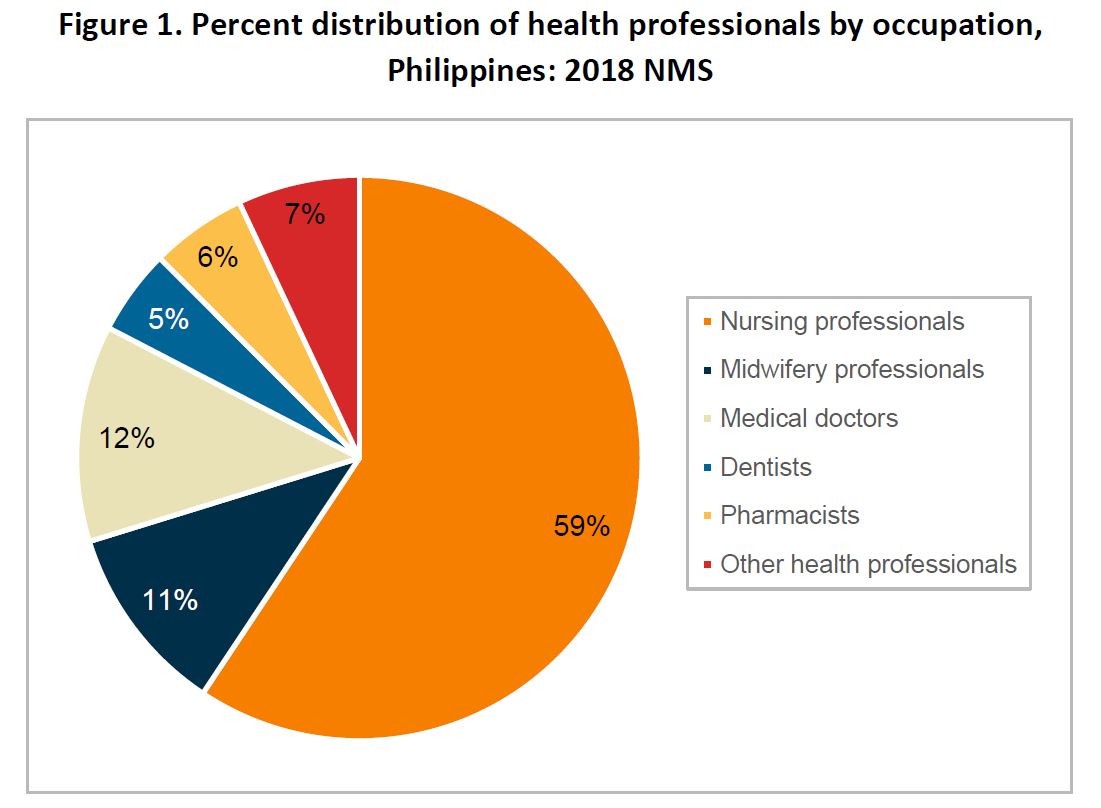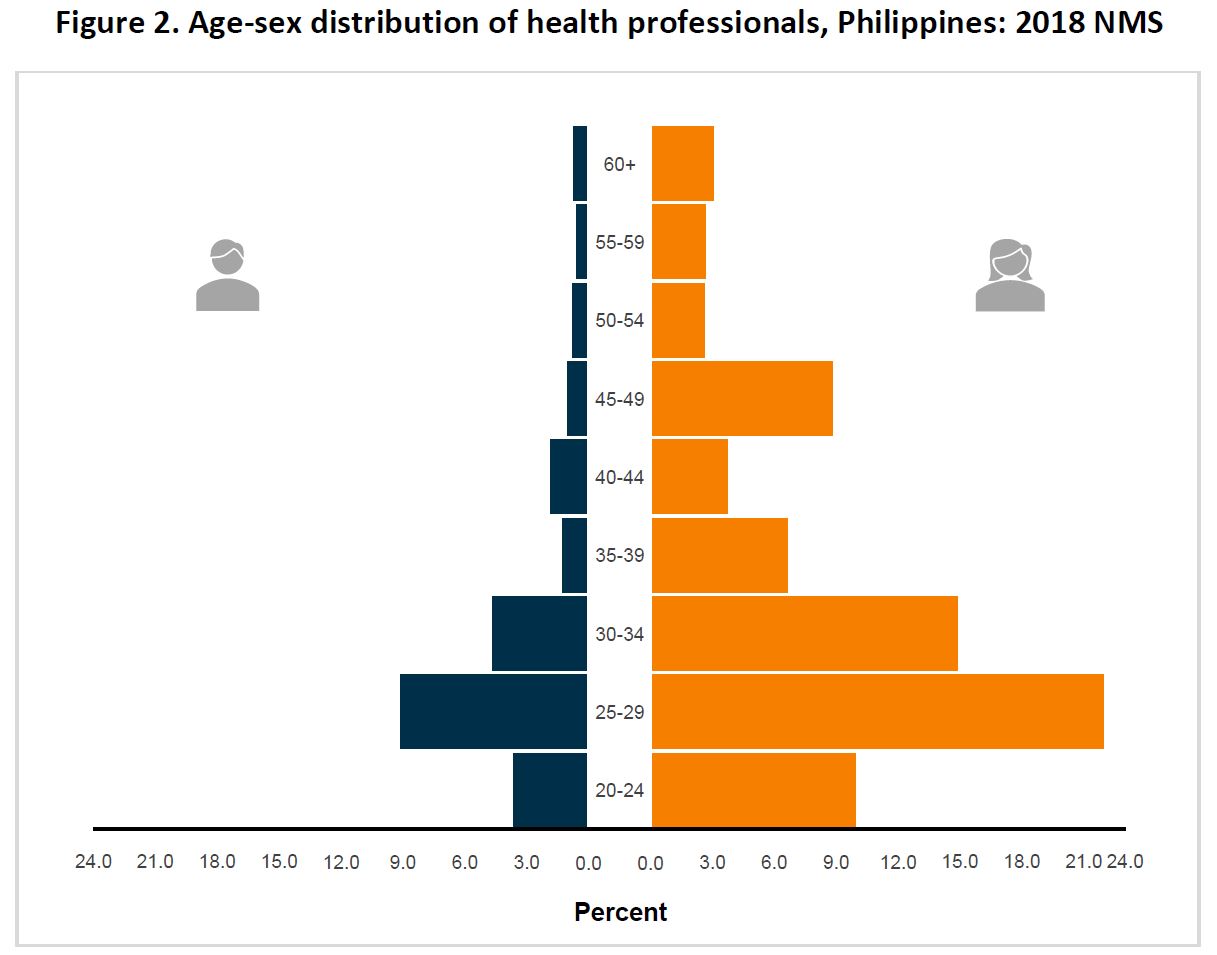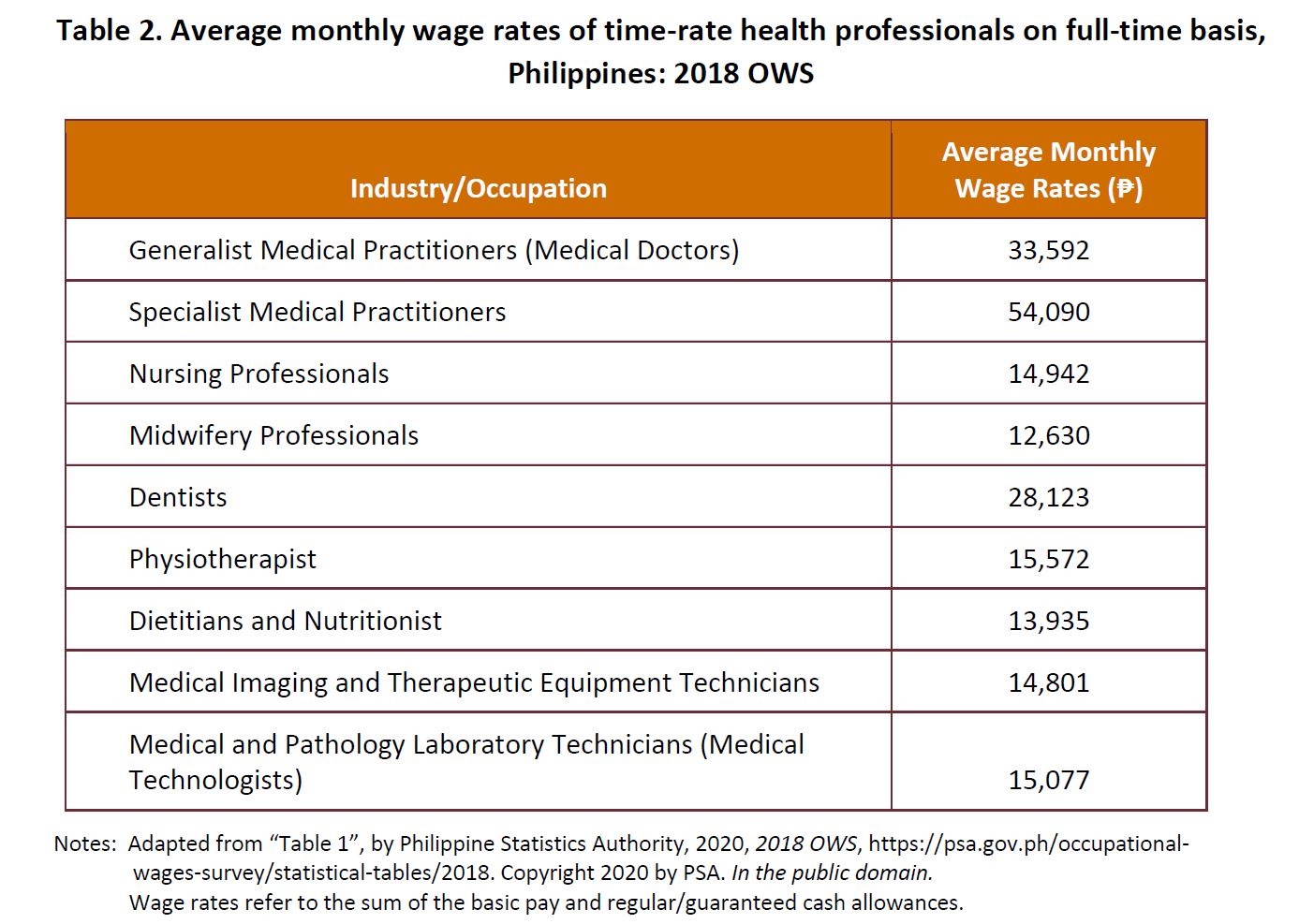
Human Resource for Health in the Time of the COVID-19 Pandemic: Does the Philippines Have Enough?
The University of the Philippines Population Institute (UPPI) in collaboration with the Demographic Research and Development Foundation (DRDF) are sharing results of their demographic studies to provide the Philippine context on the possible effects of the coronavirus disease (COVID-19) pandemic. In both the UPPI and DRDF websites, we are publishing a series of research briefs focusing on various aspects of Filipino lives that are affected by COVID-19, in both the short and long terms.
Download PDF here.
The Philippines has the highest coronavirus disease (COVID-19) outbreak in Southeast Asia with infections soaring to over 160,000 as of 17 August 2020. The country’s health system is overwhelmed. Fatigued and diminished with infections and deaths among their ranks, the medical frontliners have called for a “timeout” to draw up a better plan to deal with the coronavirus crisis. As of 3 August 2020, data from the Department of Health show that about 5% of the total COVID-19 cases in the country are health workers, 38 of whom have died due to the virus (Tomacruz, 2020). To beef up the healthcare workforce, the government is seeking to immediately hire 10,000 additional health workers, calling on universities and medical groups to help in hiring more doctors, nurses and other medical staff, including those returning medical professionals who have lost their jobs overseas.
This research brief aims to bring to fore, the implications of the increasing number of COVID-19 positive cases on the need to have more health care workers and of the importance of protecting those in the line of duty. We highlight the gap in the country’s health workforce, particularly in the number of doctors, nurses and midwives prior to COVID-19 pandemic based on the latest census data of 2015, and projections on the health professionals in the country. The analysis also draws information from the 2018 National Migration Survey (NMS) which provides detailed information on health professionals by occupation category (PSA & UPPI, 2019) and the 2018 Occupation Wages Survey (OWS), a survey conducted by the Philippine Statistics Authority (PSA) nationwide every two years covering establishments employing at least 20 workers.
This analysis hopes to provide information that will help guide policy formulation in human resource for health (HRH), the most crucial factor in the current fight to contain the pandemic.
Gaps in the required number of health professionals
Data from the World Health Organization (WHO) show that there are six medical doctors per 10,000 population in the Philippines in 2017, which is lower than the recommended ratio of 10 doctors per 10,000 population (WHO, 2018). The doctor to population ratio in the country is also lower compared to other Southeast Asian countries, like Vietnam (8 per 10,000), Thailand (8 per 10,000) and Timor Leste (8 per 10,000). The comparable figures in developed countries such as Italy and the United States are 40 and 26 per 10,000 population, respectively.
In 2019, prior to the onset of the COVID-19 pandemic, the Human Resources for Health Network (HRHN), an inter-agency policy and program support network led by the Department of Health (DOH) estimated a shortage of about 290,000 health workers in the country. This is based on the WHO indicative HRH ratio of 44.5 HRH to 10,000 population for the attainment of Sustainable Development Goals (SDGs). In addition, there is an annual out migration of 13,000 health care professionals which aggravates the deficiency in the national supply of health care workers (POEA, 2020).
The supply side of health professionals
Based on the 2015 Census of Population, there are nearly half a million (488,800) health professionals in the Philippines. The 2018 NMS estimates that less than one percent of all employed Filipinos living in the Philippines are working as health professionals. Among all health professionals in the country, majority are nurses (59%), about 1 in 9 is a medical doctor (12%) and 1 in 10, a midwife (11%) (Figure 1).

The health profession is dominated by women (75%), and the young (Figure 2). Sixty five percent of those in the health profession is under the age of 35, or most commonly referred to as the millennial generation. Less than five percent of health professionals in the country are 60 years old and over. The average age of health professionals in the Philippines is 33 years for men and 35 years for women.

Given their young age profile, it is not surprising that nearly half of our health professionals are single (48%) (Table 1). Similar proportion (48%) are currently married or are cohabiting with a partner. Almost all health professionals in the country live with at least one person. In fact, more than half of them live in a household with at least five members, and a majority still live with their parents. Moreover, about 40% live with an older person aged 60 years old and over.
In terms of socioeconomic status measured by household wealth index, less than 10% live in poor households (bottom two quintiles), and over 80% belong to the top two socio-economic quintiles. About 8 in 10 are permanently employed, while 1 in 6 is employed on a short-term or seasonal basis. Almost half of Filipino health professionals are employed in private establishments, while around 4 in 10 are working for the government or a government-owned and controlled corporation (GOCC).
Data from the 2018 OWS indicate that most health professionals receive a monthly wage that is below the national average which is ₱ 18,1081 as of 2018 level. Of the health professionals covered in the OWS, only the Specialist Medical Practitioners (₱ 54,090), Generalist Medical Practitioners (₱ 35, 592), and Dentists (₱ 28,123) receive a monthly wage that is higher than the national average (Table 2). Nurses and midwives receive a monthly wage of ₱ 14,942 and ₱ 12,630, respectively. This level suggests that nurses and midwives in the country are living just above poverty threshold, based on the 2018 per-capita poverty threshold level for a household with five members.


Shortage amidst surplus
The Philippines trains more health professionals than it can employ. A study to develop projection tools upgrading, scenario building and staffing patterns for the Health Sector Reform Program in 2017 (Ogena, 2018) showed two future scenarios for the health human resources in the country. When compared with the WHO recommended threshold or minimum health workforce required to attain universal health care (UHC) and sustainable development goals (SDG), the projected number of doctors, nurses and midwives (DNM) under Scenario 1 consistently showed a deficit from 2017 to 2030 while the deficit in the number of DNM is expected to be eventually resolved with a surplus beyond 2027.2
Despite the huge number of health professionals that the country produces every year, there is still a shortage of health workforce employed to meet the standard requirement for the country’s growing population. A large factor of this is the continuous out migration of health professionals. Based on the 2015 Census, almost a fifth of the total health professionals in the Philippines are working overseas. The lopsided distribution of health professionals in the younger age group is a reflection of this ongoing trend. More skilled and experienced health professionals are likely to have left already for better opportunities in other countries. Through time, this outmigration is motivated by factors such as low pay and lack of opportunities for professional development coupled with increasing cost of a medical education.
The HRH shortage was made more acute in the context of the COVID-19 pandemic. The rapid pace of the infection in the country has prompted the government to declare a national state of emergency, mandating the temporary suspension of the deployment of all health care workers, including among others, nurses and medical doctors/physicians. This temporary halt will hold until the national state of emergency is lifted and until COVID-19-related travel restrictions are lifted at the destination countries. The directive will ensure the sustained supply of sufficient health personnel to meet any further contingencies, especially to replace, substitute or reinforce existing workforce that are currently facing stress.
Accelerating health human resource intervention in time of pandemic
The outbreak of the COVID-19 pandemic that resulted in a sudden spike in health service requirements exposed the long-standing vulnerabilities of HRH in particular, and the country’s health system in general. The inadequate number of health personnel provided by our health system has constrained the country’s ability to effectively respond to the overwhelming demand for health services during this time of pandemic. The pandemic also highlights the deficiency in specific areas of medical training and expertise as evident in the lack of gerontologists and geriatricians to meet the unique needs of the large number of COVID-19-infected older people.
It is important to underscore the long-standing issues related to the HRH such as low pay, high turn-over rate of trained personnel, and out migration of the country’s experienced health professionals. The government’s recent move to increase the salary of newly hired nurses is a welcome development to keep them in the service even as the government has directed the temporary stop for them to leave for overseas employment. But the recent upgrading in the salary scale of government nurses may still not be enough. Based on the Department of Budget and Management Circular 2020-4 (DBM, 2020), amidst the COVID-19 pandemic and applying the rates provided for by RA 11466 that modifies the salary schedule of civilian government personnel, the starting salary of nurses is expected to be ₱ 32,053 at a minimum, beginning January 2020. It must be noted however, that the salary schedule provided for in RA 11466 may be lower for some local government units depending on their classification. For sixth class municipalities, they can only provide 65% of the rate stipulated in RA 11466. This means that nurses who work in these municipalities can only get ₱ 20,834.45. COVID-19 is expected to linger for some time, and health workers will continue to be in harm’s way. Health workers are demanding for COVID-19 hazard pay on top of the current hazard pay the are getting, the provision of ₱ 100,000 to all COVID-19 positive healthcare workers, and implementation of a seven-day work with two-weeks quarantine work schedule (Gonzales, 2020). It is thus urgent that the government further study the concerns of the health personnel.
Now is a good time to revisit the salaries and benefits of health personnel to make sure the hazards of their profession are taken care of and their services are well compensated. As the world reels from the effects of this global pandemic that require an even greater number of trained health personnel, the lure of work abroad threatens to further diminish the already inadequate human health resource in the country. The government will do well to stem the health worker migration by giving them enough reason to stay and serve their country where they are most needed.
References:
Department of Budget and Management (DBM). (2020, July). Upgrading of the Entry Level of Nurse Positions. (Circular 2020-4). https://www.dbm.gov.ph/index.php/255-latest-issuances/budget-circular/bu…
Gonzales, C. (2020, August 14). Union calls on PGH, gov’t to resolve ‘sad plight’ of health workers, Philippine Daily Inquirer. https://newsinfo.inquirer.net/1321731/union-calls-on-pgh-govt-to-resolve…
Ogena. N.B. (2018). Develop Projection Tools Upgrading, Scenario Building, and Staffing Patterns. Technical Assistance for the Philippine Health Sector Reform Contract of the European Union’s DCI-ASIA Programme for the Philippines. EuropeAid/135186/DH/SER/PH
Philippine Overseas Employment Association (POEA). (2020, April). GBR No. 09 Series of 2020. http://www.poea.gov.ph/gbr/2020/GBR-09-2020.pdf
Philippine Statistics Authority (PSA) and University of the Philippines Population Institute (UPPI) (2019). 2018 National Migration Survey. Quezon City, Philippines: PSA and UPPI.
Philippine Statistics Authority (PSA). (2020). Table 1. In 2018 Occupational Wages Survey (OWS). https://psa.gov.ph/occupational-wages-survey
Salary Standardization Law of 2019, RA 11466. (2019). https://www.officialgazette.gov.ph/downloads/2019/12dec/20200108-RA-1146…
Tomacruz, S. (2020, August 3). PH health workers infected with coronavirus reach 5,008, Rappler. https://rappler.com/nation/health-workers-coronavirus-cases-philippines-…
World Health Organization. (2018). The 2018 Update, Global Health Workforce Statistics. http://www.who.int/hrh/statistics/hwfstats/
1 Refers to the average monthly wage rate across the selected occupations in the selected industries.
2 (1) The model accounted for three major assumptions: (1) the K-12 program and free tertiary-level education is fully implemented with education institutions in the country compliant to demand changes over time for health-related academic courses; (2) there is continuing positive trend in the demand for health professionals overseas and at the national level; and (3) returning health professionals from abroad are absorbed in the Philippine health care system should they decide to continue practicing their professions upon return to the country.
(2) Two probable scenarios were considered for the projections based on the above-mentioned assumptions and views expressed by heads of health professional associations. For Scenario 1, the entry component for Doctors and Dentists (DD) and Nurses and Midwives (NM), will grow beginning 2018 at the same rate as the overseas demand for temporary workers. This implies that HRH production in the Philippines is responding positively to overseas demand for health professionals. The exit component of DD and NM are allowed to grow geometrically based on input data. On the other hand, the entry component of Professions Allied to Medicine (PAMs) and Professional and Technical (PT) workforce are allowed to grow geometrically based on input data. However, its exit component allows 10% of the PAMs and PT health workforce to leave for overseas work. Scenario 2 is similar to Scenario 1 except for the exit component of DD and NM, which is made similar to the exit component of PAMs and PT that allows 10% to leave for overseas work.
This research brief was prepared by Jeofrey B. Abalos, Grace T. Cruz, Nimfa B. Ogena, Maria Midea M. Kabamalan, Elma P. Laguna, Maria Paz N. Marquez.
Suggested citation: University of the Philippines Population Institute (UPPI) and Demographic Research and Development Foundation, Inc. (DRDF). (2020, August). Human Resource for Health in the Time of the COVID-19 Pandemic: Does the Philippines Have Enough? (UPPI/DRDF Research Brief No. 8). Retrieved from https://www.uppi.upd.edu.ph/sites/default/files/pdf/COVID-19-Research-Brief-08.pdf.
